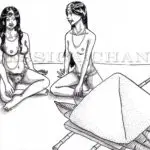Ancient CHamoru/Chamorro Use of Rice
Table of Contents
Share This
Rice cultivated in the Marianas
In the Mariana Islands, as well as other islands throughout the Pacific, rice is considered one of the most important food staples. Bags of rice are shipped to the islands regularly. In the Marianas, rice is served at most every meal or special occasion. Fiesta plates are not complete without rice. Because much of our rice is imported today, many people are surprised to learn that the ancient CHamorus/Chamorros cultivated rice. However, during the Spanish era, another starchy plant, corn, was introduced, and soon tortillas – known in the Marianas as titiyas – were added to the traditional starches of rice, taro, yams and breadfruit.
According to early historic accounts, rice (Oryza sativa) was produced in large quantities, and was used as a commodity for trade between islands and later, with the Europeans to obtain metal. Rice, however, is significant archaeologically because the CHamorus of the Marianas were the only Pacific Island people who cultivated rice in the tropics dating back to ancient times.
While the cultivation of rice provides further evidence for the theory of the origin of CHamorus from Southeast Asia, it may also suggest contact between rice-growing peoples from the Philippines or Asia and the CHamorus. The circumstances of these contacts, obviously, are unknown.
In the CHamoru language, there are different words related to rice that linguists believe show links with other Austronesian cultures. These words include fa’i (rice growing in the field), fama ayan (rice field), timulo (harvested rice stalk piles), cha’guan aga’ga (jungle rice), tinitu (husked rice), pugas (uncooked rice), hineksa’ (boiled or cooked rice), and alaguan (rice soup or rice drink).
Historic accounts by early European visitors indicate that rice was grown and used for trade between villages and with European vessels, but the CHamorus cultivated rice long before Ferdinand Magellan‘s expedition landed in the Marianas in March 1521. An archaeological report from 1971 included evidence of a rice grain impression on a piece of ancient pottery found in Rota that dated hundreds of years before the arrival of the Europeans.
Rice crops were grown using swidden (slash and burn) agriculture methods, whereby natural vegetation was cut and burned or buried to clear areas for cultivation and enrich the soil. Rice was planted by hand in natural swamps with the use of a kind of wooden digging stick or hoe known as a tatum. Swampy areas near the villages of Hagåtña, Hågat, Talofo’fo’ and Malesso’ were ideal places for planting rice. Planting was done in the CHamoru lunar month of Fa’gualo, the equivalent of late October in the modern calendar, and harvested almost half a year later using bamboo knives or tools fashioned from the edge of conch shells.
The rice was then husked using a wooden pestle called a fa’lu and stone mortar, or lusong. The husked rice was collected on woven mats and stored in baskets or clay pots for later use. One possible method for cooking rice involves wrapping the raw grains in banana leaves and placing them in a green bamboo tube filled with water. The tube was then placed over a low fire, cooking the rice before the bamboo caught fire. Clay pots may also have been used to boil rice, but this is not certain, as no pot sherds (fragments) with residue from rice starch have been recovered yet.
The Spanish who traveled through the Marianas for provisions described rice as a trade item between villages, as well as one of the items presented to them to trade for iron. Catholic missionaries also observed that rice was a ceremonial food, reserved for special occasions such as funerals, fiestas, war rituals and marriages. Spanish friar Fray Juan Pobre de Zamora, who lived among the CHamorus in Rota in 1602, observed a kind of rice drink mixed with water or coconut milk that was served to the skulls of their ancestral spirits after successful fishing expeditions.
Ceremonial uses
However, Pobre’s experience is predated by that of another Spanish missionary, Fray Antonio de los Angeles, who lived among the CHamorus on Guam from 1596-1597. Fray Antonio observed that CHamorus served rice “cooked only with water” during their fiestas. At funerals, the people who sang for the dead would be served rice from the family of the deceased, along with a drink.
CHamorus also celebrated a yearly fiesta at Fouha rock where the spirit goddess Fu’una had created the CHamoru people. There, the natives prepared rice cakes and presented them as offerings. The blessed rice would then be kept later and taken back to their villages to cure the sick. Ancient CHamorus also used rice in other important ceremonies such as marriages and childbirth rituals and customs.
Hineksa’ sinagan, for example, were prepared rice cakes formed in the shape of a large pyramid and given as wedding gifts. In addition, rectangular-shaped kottot baskets (made of woven pandanus) filled with rice were also valuable gifts for weddings and childbirth celebrations.
Although not as spiritually significant for Marianas society today, the imported, processed rice we eat is used extensively in a variety of dishes, including potu (tuba rice cakes), empanada (a meat and rice turnover), chalakiles (an achote flavored toasted rice soup), champulado (chocolate rice pudding) and hineksa’ aga’ga (red rice). Nevertheless, rice is archaeologically and culturally significant for the CHamoru people because of its long and unique history in the Mariana Islands.
Did you know?
Rice as Evidence – Linguistic evidence suggests that the first CHamoru migrants may have brought the knowledge of rice cultivation with them when they settled in the Mariana Islands, and archaeological evidence shows that rice was an important part of the ancient CHamoru culture.
For further reading
Commonwealth of the Northern Mariana Islands Division of Historic Preservation. Tiempon I Manmofo’na. Ancient Chamorro Culture and History of the Northern Mariana Islands. By Scott Russell. Micronesian Archaeological Survey No. 32. Saipan: CNMIHPO, 1998.
Craib, John L., and Nancy L. Farrell. “On the Question of Prehistoric Rice Cultivation in the Mariana Islands.” Micronesica 17, nos. 1-2 (1981): 1-9.
Cunningham, Lawrence J. Ancient Chamorro Society. Honolulu: Bess Press, 1992.
Fritz, Georg. The Chamorro: A History and Ethnography of the Mariana Islands. 2nd ed. Translated by Elfriede Craddock and edited by Scott Russell. Occasional Historical Papers Series, No. 1. Saipan: Commonwealth of the Northern Mariana Islands Division of Historic Preservation, 2001.
Hunter-Anderson, Rosalind L., Gillian B. Thompson, and Darlene R. Moore. “Rice As a Prehistoric Valuable in the Mariana Islands, Micronesia.” Asian Perspectives 34, no. 1 (Spring 1995): 69-89.



